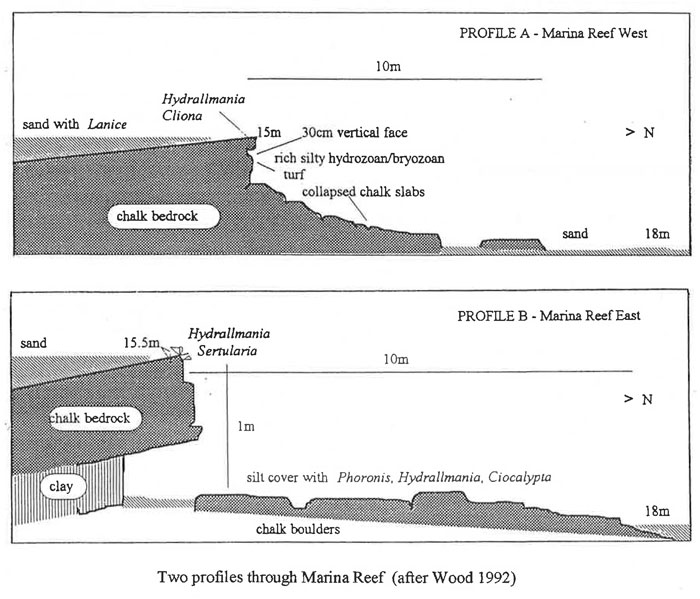SUSSEX MARINE SITES OF NATURE CONSERVATION IMPORTANCE
| Site: Marina Reef | Ref. No. 19 | ||||||
| Location: l km SSW of the entrance to Brighton Marina | Other conservation designation?: No |
||||||
| Lat./Long. position of centre of site: 50° 47' 64" N 0° 6' 66" W |
OS grid ref. of centre of site: TQ 331 011 |
Author: Robert Irving |
|||||
| Sea bed type: Reef of chalk and grey clay with chalk slabs and boulders. |
Depth range (below chart datum): 9-13 m |
Date identified: June 2001 |
|||||
Summary
Marina Reef (also known as 'Measor's Rocks') lies approximately 1 km SSW of the entrance to Brighton Marina at a depth of 9-13 m BCD. It consists of an exposure of chalk bedrock lying above a stratum of grey clay.
Biological Description
Marina Reef is said to be up to 500 m long (though this has yet to be confirmed), forming a gradual curve in plan view. Its form varies considerably along its length, the width of the raised bedrock forming the reef ranging from about 15-50 m. It rises to a maximum of 3 m above the surrounding seabed. Essentially the reef consists of an angled narrow stratum of chalk (only about 30 cm thick) with a softer grey layer beneath it. The clay is being eroded at a faster rate than the chalk, and the lower part of the reef consists of chalk slabs and boulders which have broken off following erosion of the clay base. In places the chalk bedrock has been dissected into blocks, with numerous small gullies in between, which in places form steps and ledges.
Sparse foliose red algae are present on the shallowest parts of the reef, with the upper vertical faces being dominated by a hydroid-bryozoan turf. Other larger hydroids, such as Nemertesia antennina and Hydrallmania falcata, are also present on the vertical and steeply sloping faces, along with dead man's fingers Alcyonium digitatum, fan worms Bispira volutacornis, white anemones Actinothoe sphyrodeta and various small ascidians. The horseshoe worm Phoronis hippocrepia is commonly found on upward-facing surfaces, which often have a heavy covering of silt on them. Holes at the base of the reef are likely to harbour various crustaceans, especially edible crabs Cancer pagurus, lobster Homarus gammarus and velvet swimming crabs Necora puber. The sponges Polymastia mamillaris and Ciocalypta penicillus, not often recorded elsewhere in Sussex waters, have also been noted from here. Piddocks holes are present where both the chalk and the clay are exposed. Fish associated with the reef include bib Trisopterus luscus, goldsinny Ctenolabrus rupestris and tompot blennies Parablennius gattorugine.
Between the bedrock outcrops, and also on their fringes, are patches of sand overlying the soft clay with occasional pebbles. Empty slipper limpet shells are frequently present here, with the hydroid Sertularia argentea being attached to occasional pebbles. Other regularly seen marine life in this habitat includes hermit crabs and occasional flatfish.
Justification
Sublittoral chalk exposures are unusual within the British Isles, with most being found in the South East. Marina Reef is a good example of a sublittoral chalk reef. Whilst not being particularly spectacular in its form or in the marine communities it possesses, the reef nonetheless forms an oasis of life surrounded by vast expanses of relatively barren sand.
References:Irving, R. A. 1999. Report of the Sussex Seasearch Project, 1992-1998 Sussex SEASEARCH Project, English Nature, Lewes, and Brighton & Hove Council, Brighton |
|||||||
| Sussex SEASEARCH dive nos.: 713/53-55, 58, 715/1, 8, 717/1, 2, 4 & 5 | |||||||
Site Location

Diagrammatic representation of site: Marina Reef


:Link to this page
Copyright Sussex Biodiversity Records Centre © 2025